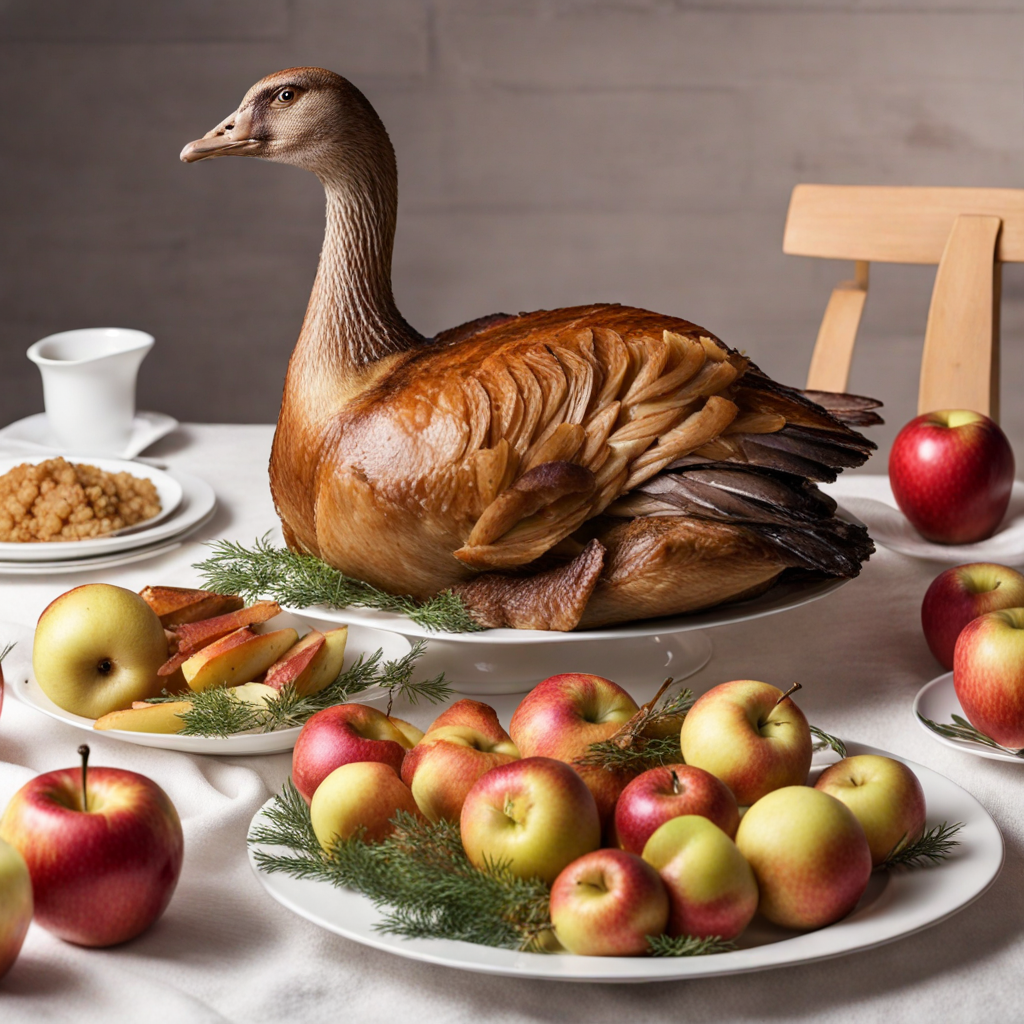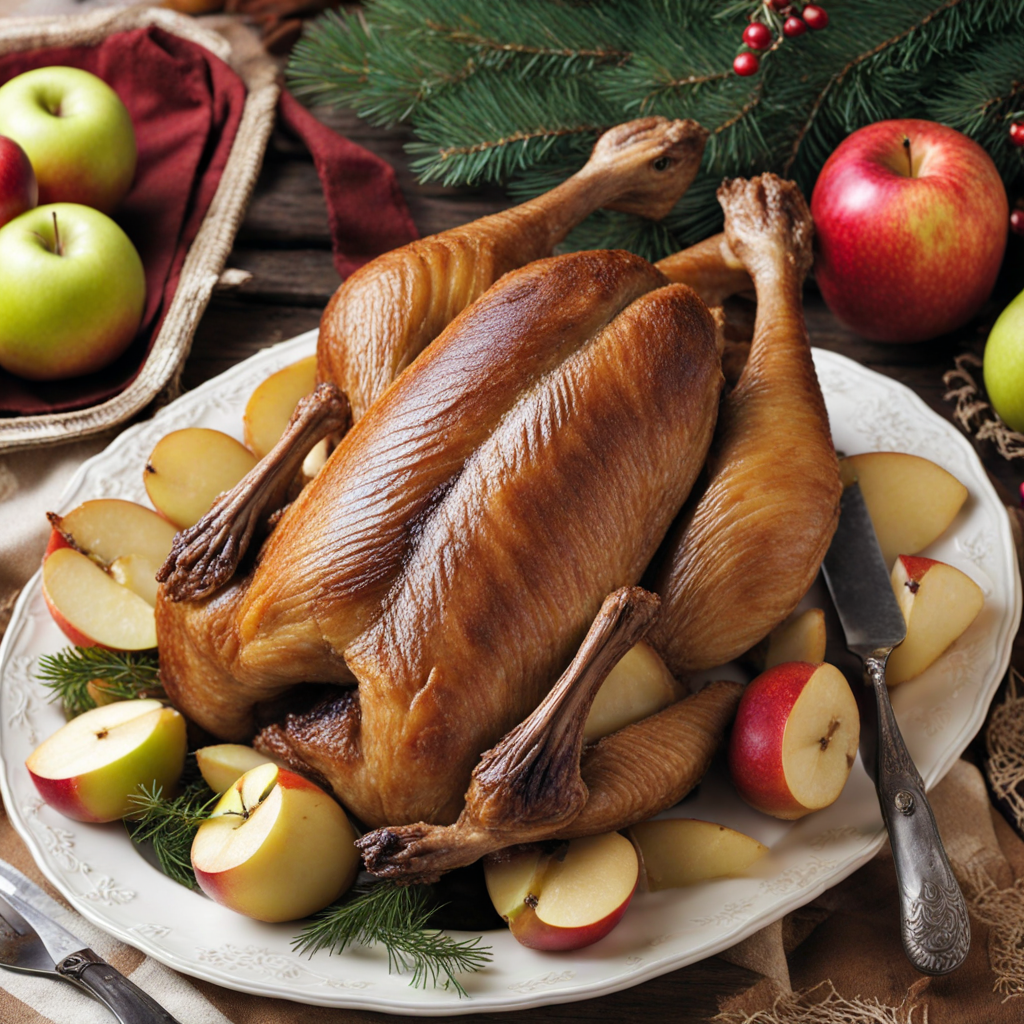Goose with Apples
In Estonia, the dish 'Goose with Apples' is a delightful fusion of rich flavors and traditional ingredients that embody the essence of the region's culinary heritage. The goose, known for its tender and succulent meat, is typically slow-roasted to perfection, allowing the fat to render beautifully, creating a crispy, golden-brown skin. This method of cooking ensures that the meat remains juicy and flavorful, making each bite a savory experience. The use of local goose, often sourced from nearby farms, highlights the importance of fresh, high-quality ingredients in Estonian cuisine. Complementing the savory profile of the roasted goose, fresh apples are incorporated into the dish, adding a sweet and tangy contrast that enhances the overall flavor. These apples, often sourced from local orchards, are usually caramelized or roasted alongside the goose, allowing their natural sweetness to intensify. The combination of the rich, fatty meat with the bright, fruity notes of the apples creates a harmonious balance that is both comforting and refreshing, appealing to a wide range of palates. Served as a centerpiece for festive gatherings or special occasions, 'Goose with Apples' is often accompanied by traditional Estonian sides such as creamy mashed potatoes, hearty rye bread, or pickled vegetables. The dish not only showcases the agricultural bounty of Estonia but also reflects the warmth of its culture, inviting diners to indulge in a communal experience filled with laughter and shared stories. Each forkful offers a taste of Estonian tradition, making it a must-try for anyone seeking to explore the unique flavors of this enchanting country.
How It Became This Dish
Hani Õuntega: The Estonian Goose with Apples Origins of Hani Õuntega Hani õuntega, which translates to "Goose with Apples," is a traditional Estonian dish that beautifully embodies the rustic flavors of the country's agricultural heritage. This dish, a celebration of local produce and seasonal ingredients, has its roots deep in Estonian culture, reflecting the interconnectedness of the land, the seasons, and the culinary traditions that have evolved over centuries. Historically, Estonia has been an agrarian society, where the cultivation of grains, fruits, and livestock was paramount to survival. The goose, a bird well-suited to the wet and temperate climate, became a staple in Estonian households. Geese were not only valued for their meat but also for their feathers, which were used for bedding and insulation. They were often raised in free-range environments and fed on natural grasses and grains, contributing to their rich flavor. The use of apples in the dish signifies the importance of fruit cultivation in Estonia. Apples were among the first fruits cultivated in the region, brought by the German and Swedish influences during the Middle Ages. The apple tree thrived in Estonia’s climate, producing various varieties that became staples in local diets. In the context of hani õuntega, apples complement the robust flavor of the goose, adding a sweetness that balances the dish. Cultural Significance Hani õuntega is more than just a meal; it is a symbol of Estonian identity and tradition. The dish is often prepared for special occasions, such as family gatherings, holidays, and festive celebrations. In rural areas, it is customary to serve hani õuntega during Christmas, symbolizing abundance and the celebration of the harvest season. The preparation of hani õuntega is often a communal affair, bringing together families and friends in the kitchen. This communal cooking not only fosters a sense of belonging and togetherness but also reinforces the transmission of culinary traditions from one generation to the next. Recipes are often passed down through families, each adding their own unique twist, which contributes to the dish's evolving nature. In Estonian folklore, geese are associated with good fortune and prosperity. Their presence in the household is believed to bring blessings, and thus, hani õuntega can also be seen as a dish that invokes well-wishes and positive energy for the future. The ritual of preparing and sharing the meal becomes a way to strengthen community bonds and celebrate cultural heritage. Development Over Time As Estonia navigated through various historical periods, particularly the influences of foreign powers and the shifting socio-economic landscape, hani õuntega adapted and evolved. In the 19th century, with the rise of nationalism, there was a renewed interest in traditional Estonian cuisine as a means to assert cultural identity. Hani õuntega, along with other traditional dishes, was celebrated as a symbol of Estonia’s culinary heritage. The 20th century brought about significant changes in Estonia’s agricultural practices and food production. The post-World War II era saw the collectivization of farms, which affected the way food was produced and consumed. However, traditional recipes like hani õuntega persisted, albeit with modifications. As urbanization increased, the access to fresh, locally sourced ingredients became more challenging, leading to adaptations in preparation methods and ingredient availability. With the restoration of independence in the 1990s, there was a resurgence in the interest in traditional Estonian food. Chefs began to explore and revive the country’s culinary heritage, leading to a renaissance of classic dishes, including hani õuntega. Modern interpretations began to emerge, incorporating contemporary cooking techniques while respecting the essence of the original dish. This evolution reflects a broader trend in gastronomy, where chefs seek to honor tradition while embracing innovation. Today, hani õuntega is celebrated in restaurants across Estonia, often featured on menus that showcase local and seasonal ingredients. Chefs experiment with different apple varieties, infusing the dish with unique flavors that reflect the diverse terroir of Estonia. The dish is not only a staple during festive occasions but has also found its place in the modern culinary scene, appealing to both locals and tourists alike. Conclusion Hani õuntega stands as a testament to Estonia’s rich agricultural history and culinary traditions. It encapsulates the harmonious relationship between the land and its people, showcasing the importance of local ingredients and the rituals of communal cooking. As Estonia continues to evolve, hani õuntega remains a cherished dish that connects generations, celebrating both the past and the present. The story of hani õuntega is one of resilience and adaptation, reflecting the broader narrative of Estonian culture. It invites us to appreciate not only the flavors but also the stories and traditions embedded within each bite. As we savor this dish, we partake in a culinary journey that honors the spirit of a nation, reminding us of the significance of food as a vessel for memory, identity, and community.
You may like
Discover local flavors from Estonia







